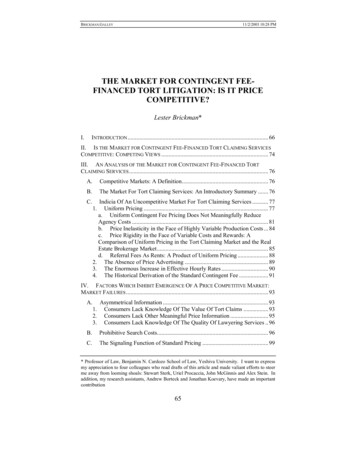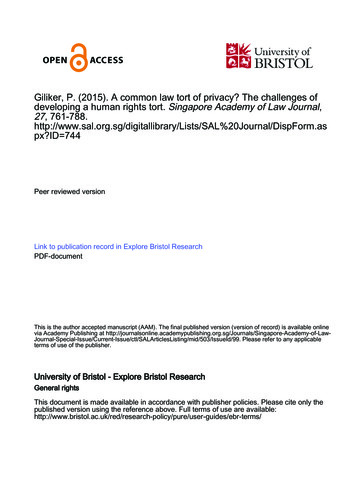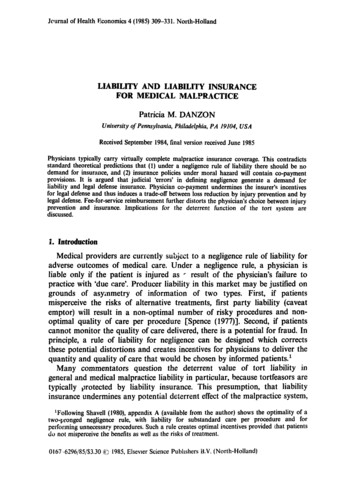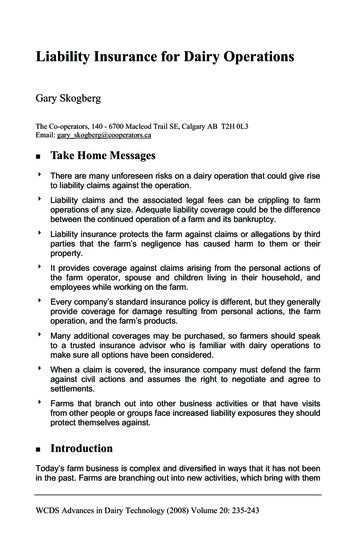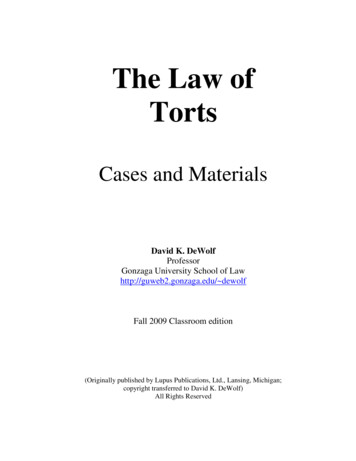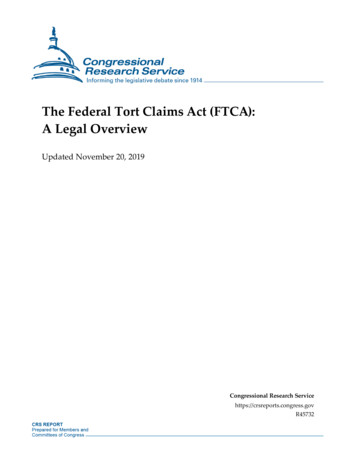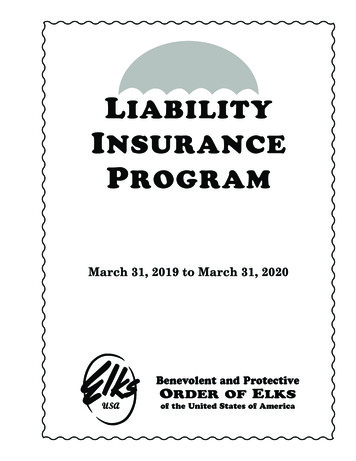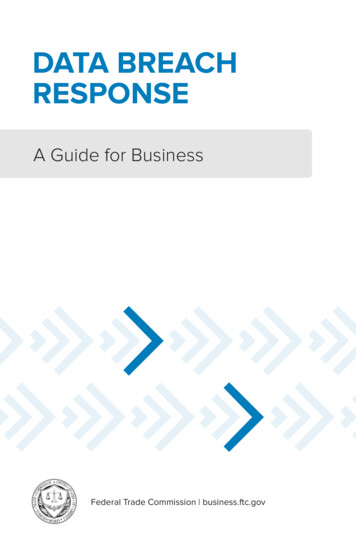
Transcription
Presenting a live 90-minute webinar with interactive Q&AAvoiding Tort Liabilityin Breach of Contract ActionsLeveraging the Independent Tort and Economic Loss Doctrinesand Mitigating Risk with Effective Contract ProvisionsTHURSDAY, OCTOBER 31, 20131pm Eastern 12pm Central 11am Mountain 10am PacificToday’s faculty features:Robert E. Byrne, Jr., MartinWren, Charlottesville, Va.Charles Eblen, Partner, Shook Hardy & Bacon, Kansas City, Mo.Amy G. Doehring, Partner, McDermott Will & Emery, ChicagoThe audio portion of the conference may be accessed via the telephone or by using your computer'sspeakers. Please refer to the instructions emailed to registrants for additional information. If youhave any questions, please contact Customer Service at 1-800-926-7926 ext. 10.
Tips for Optimal QualityFOR LIVE EVENT ONLYSound QualityIf you are listening via your computer speakers, please note that the qualityof your sound will vary depending on the speed and quality of your internetconnection.If the sound quality is not satisfactory, you may listen via the phone: dial1-866-869-6667 and enter your PIN when prompted. Otherwise, pleasesend us a chat or e-mail sound@straffordpub.com immediately so we canaddress the problem.If you dialed in and have any difficulties during the call, press *0 for assistance.Viewing QualityTo maximize your screen, press the F11 key on your keyboard. To exit full screen,press the F11 key again.
Continuing Education CreditsFOR LIVE EVENT ONLYFor CLE purposes, please let us know how many people are listening at yourlocation by completing each of the following steps: In the chat box, type (1) your company name and (2) the number ofattendees at your location Click the SEND button beside the boxIf you have purchased Strafford CLE processing services, you must confirm yourparticipation by completing and submitting an Official Record of Attendance (CLEForm).You may obtain your CLE form by going to the program page and selecting theappropriate form in the PROGRAM MATERIALS box at the top right corner.If you'd like to purchase CLE credit processing, it is available for a fee. Foradditional information about CLE credit processing, go to our website or call us at1-800-926-7926 ext. 35.
Program MaterialsFOR LIVE EVENT ONLYIf you have not printed the conference materials for this program, pleasecomplete the following steps: Click on the symbol next to “Conference Materials” in the middle of the lefthand column on your screen. Click on the tab labeled “Handouts” that appears, and there you will see aPDF of the slides for today's program. Double click on the PDF and a separate page will open. Print the slides by clicking on the printer icon.
DISTINGUISHING BETWEEN ATORT AND CONTRACT CLAIMRobert E. Byrne, Jr.MartinWren, P.C.Charlottesville, VAwww.martinwrenlaw.combyrne@martinwrenlaw.com
Contract or Tort – How to Distinguish?Macro Level Contracts facilitate and enforce transactions ofbargained-for exchanges.– Rules established by parties. Torts allocate responsibility and loss on asocial compact, large scale level.– Rules based on societal standards, i.e., reasonableperson.6
Contract v. Tort – How to Distinguish?Micro Level – Elements Contracts– Enforceable Contract– Breach of the Contract– Harm caused by breach7 Tort––––DutyBreachCausationHarm
The Elements in a Nutshell -Similarities In essence, both claims involve same generalelements– Duty– Breach– Causation– Harm Academic difference only?– Proof for breach and causation is of same type foreither claim8
The Elements in a Nutshell -Differences Stark differences arise when examining dutyand harm prongs– Duty Contracts – arises from the bargained-for exchange. Torts – arises from common-law societal standards.– Harm Contracts – apportions risk of subject of contract. Torts – looks at harms that are reasonably foreseeableand caused by Defendant’s conduct.9
Legal Doctrines for Distinguishing Tortsfrom Contracts Economic Loss Rule (focus on harm/damages)– Traditionally speaking, if product fails, not entitledto economic losses. Ex.: defective hot dog stand – no lost profits, etc.– Exception when product damages other propertyor causes injury. Independent Tort Doctrine (focus on duties)10
Legal Doctrines for Distinguishing Tortfrom Contracts Modern Approach– Two factor analysis Source of the Duty – if claim exists independently offact contract exists, the claim may sound in tort. Nature of the Injury – plaintiff’s claim normallycontract if the only loss or damage is the subject matterof the contract; if damage is beyond subject matter, theclaim sounds in tort.11
The Independent Tort Duty RuleOverview and Illustrative ExamplesGENEVA HOUSTON KANSAS CITY LONDON MIAMI ORANGE COUNTY PHILADELPHIA SAN FRANCISCO TAMPA WASHINGTON, D.C.Charles C. EblenPartnerShook, Hardy & Bacon LLPceblen@shb.com
What is the Independent Tort Duty Rule? You can’t commit a tort without breaching a duty imposed by tort law If the duty flows only from contract, you cannot be liable in tort– No such thing as a “negligent” breach Look to the source of the duty Tort and contract are historically distinct areas of law. The IndependentTort Duty Doctrine keeps them that way13
Example!You hire an alarm company to install an alarm Man off the street has no duty to walkinside your house and install an alarmsystem. That duty flows only from the contract youtwo signed Installer had no existing duty to walkinside your house and install the alarm If he negligently installs the alarm, youlook to the contract to provide damages But if while he is installing your alarm hedecides to smash your computer with ahammer—that’s a tort 14ContractEveryone has an independent tort duty notto destroy property or harm peopleLook to the source of the dutyTort
Tort and Contract Protect Different InterestsTortContract Duty imposed by lawInvoluntaryEnforces social normsPunishes socially reprehensibleconduct—but only when society(not individuals) is harmed Compel performance or punishbreaching party Goal: Ensure standards ofconduct in society15Duty bargained for by partiesParties choose to be boundEnforces agreementsEnables commerce (sociallydesirable conduct) Compensate for any loss due tobreach Goal: Ensure freedom tocontract and sanctity ofcontracts
So Who Cares?Why is it important to distinguish tort and contract?(1) Permit Freedom of Contract Bedrock principle of capitalism Keep courts from rewriting contracts or enforcing policy concerns in private economic transactions– Contract law has its own set of safeguards in place E.g. Unconscionability, consequential damages(2) Limit Liability Confusion nullifies a principal purpose of contracting—limiting liability– Punitive damages(3) Promote Economic Efficiency Breach is a Breach is a Breach– Contract law does not get hurt feelings when something goes wrong Does not assign fault Idea of “efficient breach”– Parties define consequences of the breach Quantify risk and limit liability16
Evolution: How Courts Have Tried to Isolate Tort and Contract Law
Economic Loss Rule (“ELR”) Bars suits in tort for injuries to product caused by the product itself thatdidn’t injure persons or other property (“economic loss”) Goal: prevent contract from “drowning in a sea of tort”– Rationale: this type of injury (to the product itself) should be covered bya manufacturer's warranty and thus the consumer is limited to recoveryunder that warranty Cannot recover for lost expectation damages based on your businesslosing money when your truck’s engine breaks down– Rationale: if manufacturers faced tort liability for purely economic loss,prices would skyrocket ELD began expanding, barring suits beyond product liability– E.g. fraudulent inducement, negligent misrepresentation, consultingcontracts, investment programs, and construction project administration– Courts began to think this approach unwieldy Natural progression to return ELR to its original place as limitation ofproducts suits– How do we stop every contract action from being infused with tort?18
Sample Evolution:ELR to Independent Tort DutyCase Study—Florida Origin (1965)– Traditional Economic Loss Rule—bound tort and contract regimes, limit tort suitsin product liability Contractual Privity ELR (1987)– Mostly what we are talking about– Parties to contracts have defined limitation of liability through bargaining, riskacceptance, and compensation detailed in contract—can’t sue in tort when youalready have a contract “Unprincipled Expansion” (1990s – 2013)– Courts permitted actions in tort even in presence of contractual privity Fraud in the inducement, nonprofessional service contracts, negligentmisrepresentation, “other property” exception, Reigning in: Back to Strict Products Liability (2013)– Realizing the ELR is running wild, the Court in Tiara Condominium Ass’n., Inc. v.Marsh & McLennan Cos., Inc. recedes from precedent and determines the doctrineagain only applies in products liability– Independent tort doctrine now sole gatekeeper of tort suits (outside productsliability as ELR originally intended)19
Enter the Independent Tort Duty Rule ITD is in some ways an exception to the ELR– Preserves tort suits that may otherwise be barred by the economic lossrule– If the tort claim arises from a duty existing independently of the dutyowed under the contract, a claim for non-economic losses may proceed Concern—not enough tort?– Courts concerned that an “unprincipled expansion” of the ELR wasimproperly proscribing business torts Now, we look to origin of the duty– If the breach arises as a result of the contract—no tort liability– If the breach results from an independent common law duty—tort20
Recent Cases: New YorkNew York requires breach of an independent tort duty to bring suit outsidethe contract: Nirvana Int’l., Inc. v. ADT (2012)– Theatrical jewelry store burglary where ADT-installed motion detector failed todetect burglars removing nearly 2 million from safe in back room where motionwas located. District court granted ADT’s motion to dismiss, rejecting argumentsthat limitations in contract did not apply because customer’s signature on backpage of contract accepting provisions was a forgery. Second Circuit affirmed. Abacus Federal Savings Bank v. ADT (2012)– Bank sued alarm monitoring companies alleging breach of contract and grossnegligence resulting from overnight burglary. Court held that breach of contractoccurring as a result of gross negligence does not give rise to a duty independentof the contractual relationship. Contrast Abacus with Sommer v. Fed. Signal Corp. (1992)– Where alleged failure to act affects a significant public interest independent ofdefendant’s contractual obligations, action may sound in tort.21
CaliforniaCalifornia allows tort claims and contract claims for the same acts only whenthe acts violate independent duties Applied Equipment Corp. v. Litton Saudi Arabia Ltd., 7 Cal. 4th 503 (1994) “Conduct amounting to a breach of contract becomes tortious only whenit also violates an independent duty arising from principles of tort law.” “punitive damages may not be awarded for breach of contract ‘evenwhere the defendant’s conduct in breaching the contract was willful,fraudulent, or malicious.’” California does permit punitive damages for bad faith breaches ofinsurance contracts Tort recovery is allowed because insurance companies owe anindependent duty of good faith to society beyond the four corners of theinsurance agreement: “unlike most other contracts for goods or services, an insurance policyis characterized by elements of adhesion, public interest, and fiduciaryresponsibility.”22
ColoradoColorado’s Unique Position Willful-and-Wanton Rule– Giampapa v. American Family Mut. Ins. Co., 64 P.3d 230 (Colo. 2003) Noneconomic damages arising from breach of contract are available if the breach is willful and wanton Concurring opinion notes that “using a standard of culpability such as willfulness to determine liability in a contractcase undermines the doctrine of efficient breach.” In Colorado, parties are free to contract around the Independent Duty Rule– Colorado courts look only to whether a duty exists independent of the contract . So a duty written intothe contract is no longer an independent duty. Town of Alma v. AZCO Construction, Inc., 10 P. 3d 1256 (Colo. 2000) CO recognized the “independent duty rule” approach to the economic loss rule and held that tort claims could onlybe brought if the defendant violated a duty imposed by law, not one found only in the contract In Town of Alma, plaintiffs contracted with defendant construction company to install a water distribution system.The lines developed leaks and the plaintiffs sued, alleging negligence, breach of contract, and breach of impliedwarranty. The court applied the economic loss rule to bar the plaintiffs’ claims because the contract alreadyimposed a duty of care for installing water lines, therefore precluding the similar independent duty in tort. BRW v. Inc. v. Dufficy & Sons, Inc, 99 P. 3d 66 (Colo. 2004)– Court introduced a two-step approach to economic loss rule as seen in Alma:– (1) look to contractual relationships among parties to determine whether duty breached arises in contract; (2) if nocontractual duty, use Taco Bell v. Lannon factors: “the risk involved, the foreseeability and likelihood of injury asweighed against the social utility of the [defendant's] conduct, the magnitude of the burden of guarding against injuryor harm, and the consequences of placing the burden upon the [defendant].” The Court also incorporated three factors from Alma’s sister case, Grynberg v. Agri Tech, Inc.:– (1) whether the relief sought in negligence is the same as the contractual relief; (2) whether there is arecognized common law duty of care in negligence; and (3) whether the negligence duty differs in any wayfrom the contractual duty.23
Where Do We Go From Here? Courts should strongly endorse the independent tort duty rule Promotes freedom of contract, economic efficiency, and social policy Prevents introduction of messy tort theories into straightforward breach ofcontract cases– Prevents punitive damages from crippling businesses Push for a policy based approach to examining the underlying duty24
25Economic Loss DoctrineAmy G. DoehringMcDermott Will & Emery227 West Monroe StreetChicago, IL 60606-5096adoehring@mwe.com
26Economic Loss Doctrine: Overview What is it? Purpose Origin Scope How does it work? What are the exceptions? Current status: eroding?
27Economic Loss Doctrine:What is it? Economic loss doctrine bars tort claims seeking purelyeconomic losses Commercial or economic losses may be recovered under acontract theory Tort recovery, however, is available only for personal injury ornon-economic losses Economic loss is the diminution in value of the product itselfand the consequential damages (e.g., lost profits) resultingfrom the defective product
28Economic Loss Doctrine:What is it? What does it mean that the economic loss doctrine bars tortclaims seeking purely economic losses? Different things depending upon your jurisdiction No recovery in tort for purely economic loss, even if no contractualrelationship No tort recovery for economic loss when injury is identical to injury frombreach of contract No tort recovery for economic loss to the product itself Attempt to draw a bright line between contract and tort
29Economic Loss Doctrine:Purpose Economic loss doctrine is based upon three fundamentalprinciples Maintain distinction between tort and contract law Protect parties’ freedom to allocate risks by contract Encourage parties to assume, allocate or insure risk Contract and tort law have cross purposes Contract: parties create obligations where there were none Tort: based upon policy concerns (i.e., safety) Economic loss doctrine permits commercial parties toallocate risks and limit liability when safety concerns are notimplicated
30Economic Loss Doctrine:Origins Seely v. White Motor Co., 403 P.2d 145 (Cal. 1965) Accident resulted from a defect in the truck, causing only propertydamage to truck itself California Supreme Court held that truck manufacturer was liableonly for commercial or economic loss based upon contract/warranty No tort liability because no personal injury or damage to propertyother than truck East River Steamship Corp. V. Transamerica Delaval Inc., 476U.S. 858 (1986) Valve defect damaged ship’s turbine causing damage to the ship U.S. Supreme Court barred tort claim because plaintiff incurred onlyeconomic loss and there was no personal injury or damage to otherproperty
31Economic Loss Doctrine:Scope Since East River Steamship, most states have adopted theeconomic loss doctrine in one form or another May apply differently, depending upon the state Arkansas and Montana have declined to adopt it Other states Supreme Courts have not adopted it, but appellatecourts apply it (Pennsylvania, North Carolina, Maryland, Iowa) It has been expanded and also limited in several ways In short, it’s application is confusing and depends greatly onthe jurisdiction and facts of the case
32Economic Loss Doctrine:How does it work? Differentiate between economic loss and non-economic lossEconomic LossNon-Economic LossLoss to productPersonal injuryLost profits; lost productivityReal property damagesRepair and replace costs;cover“Other” property damagesDisappointed expectations
33Economic Loss Doctrine:“Other property” Integrated system rule: if defective product is part of anintegrated system, other components of system areconsidered product itself and economic loss doctrine barsrecovery for damage Saratoga Fishing v. J.M. Martinac, 520 U.S. 875 (1996): Defect in boat’s hydraulic system caused fire in engine room Owner added equipment to boat after purchase Supreme Court concluded that equipment added after purchasewas “other property” and owner could recover in tort for damageto the added equipment Holding reflects policy considerations relating to productsafety
34Economic Loss Doctrine:Disappointed expectations Example: Breach of requirements contract Plaintiff alleged defendant breached contract by using product inways restricted by contract Plaintiff then added fraud claim alleging that defendant committed“fraud in performance” of contract by not revealing the ways itwas using the product Defendant moved for summary judgment on fraud claim basedon economic loss doctrine since injury from “fraud” was exactlythe same as injury from breach
35Economic Loss Doctrine:Exceptions Fraud Inducement Extraneous Danger Intrinsically dangerous substance Sudden and calamitous event Independent duty Special relationship Unique circumstances Torts that cause economic harm Tortious interference Negligent misrepresentation Consumer fraud/deceptive trade practices
36Economic Loss Doctrine:Exceptions -- Fraud Example 1: Same case as “fraud in the performance” claim Fraudulent inducement claim alleging defendant never intendedto limit use of product as set forth in contract Economic loss doctrine did not apply to that claim Example 2: Contract for repair services Defendant fraudulently concealed material information to induceplaintiff to agree to additional, unnecessary repairs That fraudulent inducement claim is not barred by economic lossdoctrine
37Economic Loss Doctrine:Exceptions -- Danger These exceptions reflect policy concerns relating to productsafety Intrinsically dangerous substance Asbestos Sudden and calamitous event Also reflects issues relating to foreseeability
38Economic Loss Doctrine:Exceptions Economic loss doctrine generally does not apply to torts thatby definition cause only economic loss Tortious interference with contractual relations or prospectivebusiness relations Negligent misrepresentation Consumer fraud or deceptive trade practices Breach of fiduciary duty These torts usually involve some special relationship orindependent duty
39Economic Loss Doctrine:Eroding? Florida recently limited economic loss doctrine to productliability cases: Tiara Condo Ass’n., 110 So.3d 399 (Fla. 2013) Texas refused to expand economic loss doctrine to barrecovery for purely economic loss in negligence claimbetween non-contracting parties: Sharyland Water Supply,354 S.W.3d 407 (Tex. 2011) California permitted recovery of punitive damages when partyfalsely certified compliance with contractual provision:Robinson Helicopter., 102 P.3d 268 (Cal. 2004)
40Tort v. Contract:Practical implications Why does it matter? Statutes of limitation Insurance implications Allocation of liability and risk
41Tort v. Contract:Practical implications Contractual limitations or disclaimers Carefully draft provisions Know the law of your jurisdiction Limits on damages vs. limits on liability No matter how your contract is drafted probably cannot avoidliability for fraudulent inducement or fraud extraneous tocontract
of the contractual relationship. Contrast Abacus with Sommer v. Fed. Signal Corp. (1992) - Where alleged failure to act affects a significant public interest independent of defendant's contractual obligations, action may sound in tort. 21 . California .
